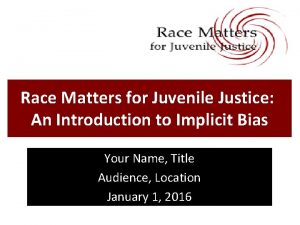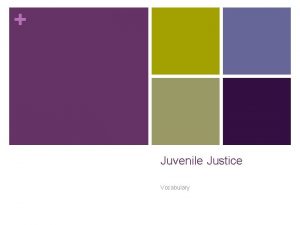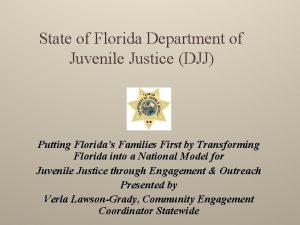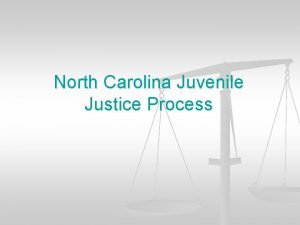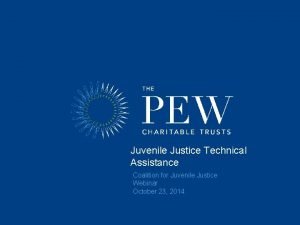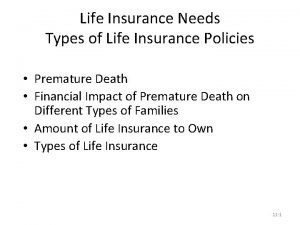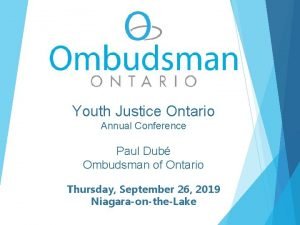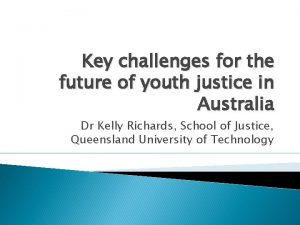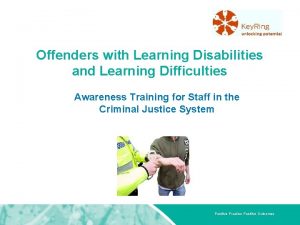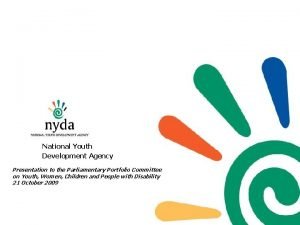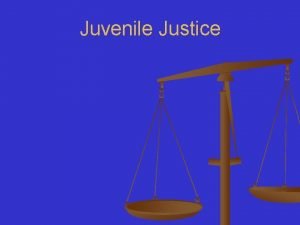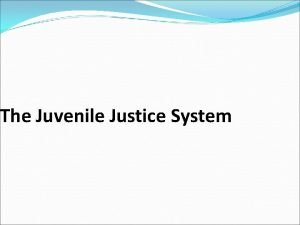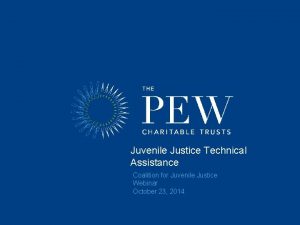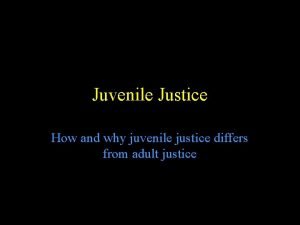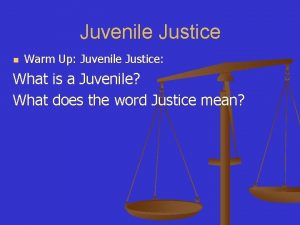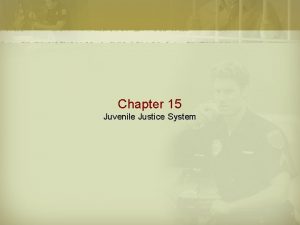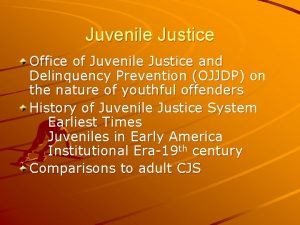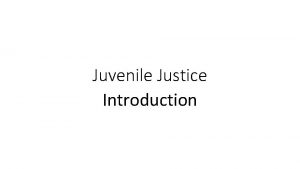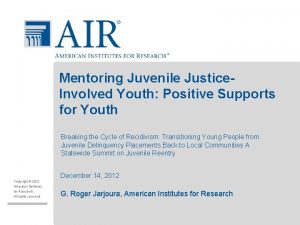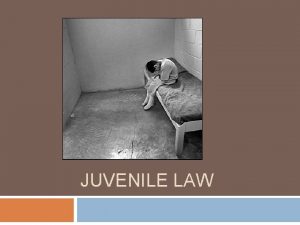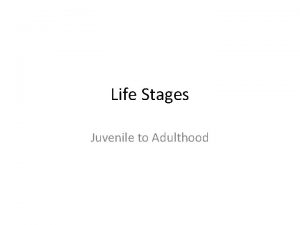Infusing Positive Youth Development into Juvenile Justice Policy























- Slides: 23

Infusing Positive Youth Development into Juvenile Justice Policy and Practice Jeffrey A. Butts, Ph. D. May 4, 2009 www. ppv. org

2 Juvenile Justice Interventions Should be Comprehensive A comprehensive approach to youth crime would address all theoretically relevant causes of youth crime… … not just causes for which we already have programs. www. ppv. org

3 Theory is Not Just for Class Papers Cause www. ppv. org Effect

4 Crime is Not a Mental Health Disorder § Some young offenders have mental health problems… and they must be treated § But mental health treatment is not crime reduction § Even a perfect mental health treatment system would not end juvenile crime and recidivism § The overlap between crime and mental health is misunderstood (and often misused) www. ppv. org

5 Prevalence of Mental Health Problems U. S. All U. S. Adolescents Juvenile Assessment Center Population (diversion) Using the same broad standard… U. S. Department of U. S. Health and Human Services (1999), Mental Services Health: A Report of the Surgeon General Surgeon 21% Probation Intake Population 69% 46% 29% Mc. Reynolds et al. (2008), Crime and Delinquency Wasserman et al. (2005), American Journal of Public Health What Does This Mean? www. ppv. org Chicago Detention Population 21% Teplin et al. (2002), Archives of General Psychiatry

6 Prevalence of Mental Health Problems Social and Economic Disadvantages Justice System Contact ? Offenders with Mental Health Problems www. ppv. org Mental Health Diagnoses

7 Substance Abuse Drug problems are also more common the deeper one looks into the juvenile justice process, from arrest, to referral, adjudication. Why? www. ppv. org

100% 8 When they first enter the juvenile system, the prevalence of substance abuse among young offenders is similar to other teens. Substance-abusing offenders, however, are more likely to be retained through to the more restrictive stages of justice processing. The preponderance of drug-abusing youth in the deep end of the justice system is a function of how case decisions are made. Drug-abusing youth are treated more coercively. 11% 25% 49% Youth at a Juvenile Assessment Center Youth Referred to Juvenile Probation Youth Held in Secure Detention www. ppv. org Thus, they are a larger subgroup by the end of the juvenile justice process.

Youth with Drug Issues are Handled More Coercively in the Juvenile Justice System § This could be an accurate and legitimate use of resources if drug-using youth are at higher-risk of future offending and in need of stronger sanctions. § Just what type of drug users are referred to the juvenile justice system? www. ppv. org 9

10 Substance Use Disorders Among Youth Referred to a Juvenile Assessment Center Abuse Disorders Alcohol Marijuana Other drug 2% 4% 1% Dependence Disorders Alcohol Marijuana Other drug No Disorder Source: Mc. Reynolds et al. (2008) www. ppv. org 1% 5% 1% 89% Among Youth Referred to Juvenile Probation Intake Abuse Disorders Alcohol Marijuana Other drug 7% 10% 3% Dependence Disorders Alcohol Marijuana Other drug 3% 13% 4% No Disorder 75% Source: Wasserman et al. (2005)

11 Substance Use Disorders of Youth Offenders § Approximately 10% to 25% of young offenders have substance use issues that could be called “problematic” – either abuse or dependence § Most of these substance use issues involve alcohol and marijuana (80% to 90%) § Very few youth ( 5% ? ) have addiction and dependence problems involving serious, illegal drugs § What should our response be? www. ppv. org

12 Where are the Programs? What intervention models do we have for young offenders not primarily affected by mental health issues or substance abuse? www. ppv. org

13 Positive Youth Development § Strengths and assets § Attachment, engagement, and socialization § Usefulness and belonging § Broad system of community-based supports § Allow all youth to experience opportunities and activities that youth in wealthy communities take for granted: • • Supportive relationships Rewards for work Skill development Success in learning www. ppv. org • • Physical activity and sports Music and the arts Civic engagement Community/political involvement

14 Youth Development Approach Evidence-based? Interventions that have been proven by rigorous evaluations to be effective in meeting their stated goals at high levels of statistical confidence. Science-based? Interventions that address specific factors shown by social science research to be associated with the extent and severity of anti-social behavior among youth. www. ppv. org Long-term Goal

15 Who “Invented” Youth Development? § Nobody “invented” it § Traces are found in the work of Jane Addams etc. (empowerment, belonging, arts, civic engagement) § 1970 s: researchers started to advance particular models Kenneth Polk and Solomon Kobrin (1972). Delinquency Prevention Through Youth Development. Washington, DC: Youth Development and Delinquency Prevention Administration. § 1990 s: A wide range of models influential in education, prevention and community-based services www. ppv. org

16 Community Network for Youth Development San Francisco National Research Council 40 Developmental Assets Institute for Applied Research in Youth Development Tufts University Promising and Effective Practices National Youth Employment Coalition National Clearinghouse and Families & Youth www. ppv. org Youth Development Framework

17 Research on Comprehensive Models Supports the potential of a youth development approach to juvenile justice interventions Hawkins and Weis “The Social Development Model: An Integrated Approach to Delinquency Prevention. ” Journal of Primary Prevention 1985 www. ppv. org

18 Survey of Youth Assets (Univ. of OK) Supports the potential of a youth development approach to juvenile justice interventions Youth with particular asset Positive peer role model Rate of weapon carrying compared to other youth 55% as likely Positive non-parental adult role model 63% Involved in community activities 48% Report future aspirations 53% Able to exercise responsible choices 63% Report good family communication 59% * 14% of sample reported some weapon carrying Aspy et al. (2004), Journal of Counseling and Development www. ppv. org

19 Change is Never Easy How Do We Transform the Juvenile Justice System to Focus Interventions on Attaching Youth to Assets and Facilitating Youth Development? www. ppv. org

20 Very Different Perspectives Traditional Justice Youth Development Target Youth deficits Youth strengths Goal Control Attachment Strategy Deter and provide treatment Connect and engage Tactics § Sanctions § Supervision § Services § Re-establish youth bonds with community § Connect youth and family with pro-social activities § Build on youth assets and interests www. ppv. org

21 Youth Development Approach May be an Evidence-Based Model Some Day Requires an accumulation of findings from numerous, high-quality studies. Depends on sustained investment by service providers, researchers, and funding sources. www. ppv. org

Contact Information Jeffrey A. Butts, Ph. D. Executive Vice President for Research Public / Private Ventures Philadelphia Office 2000 Market Street Suite 600 Philadelphia, PA 19103 New York Office 122 East 42 nd Street 42 nd Floor New York, NY 10168 www. ppv. org www. jeffreybutts. net jbutts@ppv. org www. ppv. org Oakland Office Lake Merritt Plaza 1999 Harrison St. , Suite 1550 Oakland, CA 94612

23 References Aarons, Gregory A. , Sandra A. Brown, Richard L. Hough, Ann F. Garland, and Patricia A. Wood (2001). Prevalence of Adolescent Substance Use Disorders across Five Sectors of Care. Journal of the American Academy of Child and Adolescent Psychiatry, 40(4): 419– 26. Aspy, Cheryl B. , Roy F. Oman, Sara Vesely, Kenneth R. Mc. Leroy, Sharon Rodine, and Ladonna Marshall (2004). Adolescent violence: The protective effects of youth assets. Journal of Counseling and Development 82: 268 -276. Bernburg, Jón Gunnar and Marvin D. Krohn (2003). Labeling, Life Chances, and Adult Crime: The Direct and Indirect Effects of Official Intervention in Adolescence on Crime in Early Adulthood. ” Criminology 41(4): 1287 -1318. Hawkins, David and Weiss, Joseph G. (1985). The social development model: An integrated approach to delinquency prevention. Journal of Primary Prevention, 6(2), 73 -97. Johnston, Lloyd D. , Patrick M. O'Malley, Jerald G. Bachman & John E. Schulenberg (2007). Monitoring the Future: National Survey Results on Drug Use, 1975 -2006. Volume I: Secondary school students (NIH Publication No. 07 -6205). Bethesda, MD: National Institute on Drug Abuse. Jonas, Bruce S. , Debra Brody, Margaret Roper and William Narrow (2006). Mood disorder prevalence among young men and women in the United States. In Mental Health, United States, 2004 , Chapter 17, Figure 4. Manderscheid, Ronald W. and Joyce T. Berry (Editors). Rockville, MD: U. S. Department of Health and Human Services, Substance Abuse and Mental Health Services Administration (SAMHSA), Center for Mental Health Services (CMHS). www. ppv. org Mc. Reynolds, Larkin S. , Gail A. Wasserman, Robert E. De. Como, Reni John, Joseph M. Keating, and Scott Nolen (2008). Psychiatric disorder in a juvenile assessment center. Crime & Delinquency, 54(2): 313 -334. Substance Abuse and Mental Health Services Administration (2007). National Survey on Drug Use and Health. Rockville, MD: Substance Abuse and Mental Health Services Administration. Teplin, Linda A. , Karen M. Abram, Gary M. Mc. Clelland, Mina K. Dulcan, and Amy A. Mericle (2002). Psychiatric disorders in youth in juvenile detention. Archives of General Psychiatry 59(Dec): 11331143. U. S. Department of Health and Human Services (1999). Mental Health: A Report of the Surgeon General. Rockville, MD: U. S. Department of Health and Human Services, Substance Abuse and Mental Health Services Administration, Center for Mental Health Services, National Institutes of Health, National Institute of Mental Health. Wasserman, Gail A. , Larkin S. Mc. Reynolds, Susan J. Ko, Laura M. Katz, and Jennifer R. Carpenter (2005). Gender Differences in Psychiatric Disorders at Juvenile Probation Intake. American Journal of Public Health, 95(1): 131 -137.
 Destiny 2 infusing
Destiny 2 infusing Race matters for juvenile justice
Race matters for juvenile justice Unit 2 criminal law and juvenile justice
Unit 2 criminal law and juvenile justice The juvenile justice and welfare act of 2006
The juvenile justice and welfare act of 2006 Juvenile justice vocabulary
Juvenile justice vocabulary State of florida department of juvenile justice
State of florida department of juvenile justice Expulsion
Expulsion Georgia juvenile justice system
Georgia juvenile justice system Juvenile justice act 2000
Juvenile justice act 2000 Undisciplined juvenile petition nc
Undisciplined juvenile petition nc Juvenile justice system in georgia
Juvenile justice system in georgia Coalition for juvenile justice
Coalition for juvenile justice Minnesota juvenile justice system
Minnesota juvenile justice system Features of life insurance
Features of life insurance Youth justice ontario
Youth justice ontario Youth justice quotes
Youth justice quotes Cjpp guelph
Cjpp guelph Bsa youth protection policy
Bsa youth protection policy Positive characteristics of youth
Positive characteristics of youth Catalase test
Catalase test Negative numbers rules
Negative numbers rules Positive practice positive outcomes
Positive practice positive outcomes Uyf
Uyf Nyc department of youth and community development
Nyc department of youth and community development

